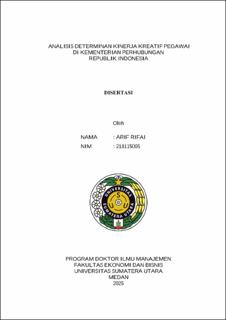| dc.description.abstract | In the era of digitalization and dynamic changes in the work environment, government organizations are required to improve the creative performance of their employees in order to face the increasing challenges and complexity of tasks. The Ministry of Transportation has a strategic role in supporting the smooth running of national transportation and logistics. Various studies have shown that there are still obstacles in optimizing employee creativity due to leadership factors, organizational support, and the use of digital systems in knowledge management. This study is important to identify determinant factors that can improve employee creative performance in the context of government bureaucracy. The purpose of this study is to analyze the determinants of employee creative performance at the Ministry of Transportation of the Republic of Indonesia, which include: transformational leadership, perceived organizational support, knowledge digital system and employee engagement.
The population of this study were the largest Civil Servants in 4 (four) Main Port UPTs in Indonesia, namely Belawan Port UPT in North Sumatra, Tanjung Periok Port UPT in Jakarta, Tanjung Perak Port UPT in East Java and Makasar Port UPT in South Sulawesi. The population in this study was 2,076 Employees. The number of samples was calculated using the Slovin formula, and the number of samples obtained was 336 Employees. Sampling was carried out using the Proportional Random Sampling method which was carried out randomly but considering the proportion of the number of employees in each work area (UPT), because the study population was spread across four UPTs with different numbers of employees so that by ensuring that each UPT had proportional representation in the sample, the research results were more accurate and reflected the overall population conditions. The data collected in the study were analyzed using quantitative analysis methods, which included: descriptive statistical analysis and inferential statistics, namely: Structure Equation Model Partial Least Square (SEM PLS).
The results of the study provide an overview that in order to improve employee creative performance, organizations need to strengthen transformative leadership styles, provide real organizational support, and build digital knowledge systems that are easily accessible and encourage employee engagement. Leadership that is able to inspire and encourage change has been shown to not only have a direct impact on employee creativity, but also strengthen their engagement and increase the use of digital knowledge systems. Consistent organizational support also plays an important role in shaping a creative work environment. These findings emphasize the importance of collaboration between leadership, digital systems, and participatory work culture in creating an innovative and adaptive bureaucracy. | en_US |


